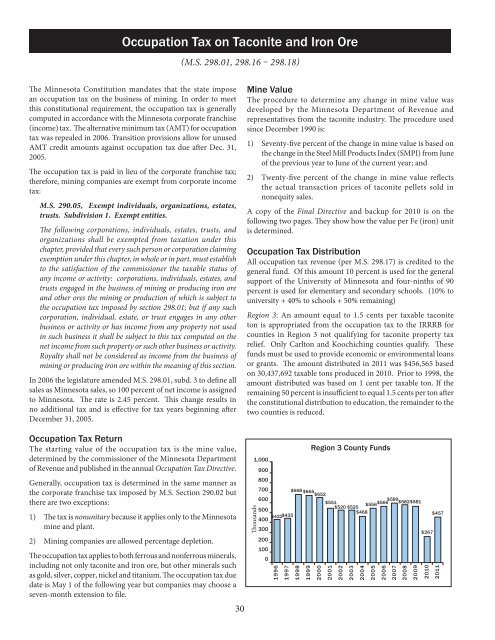Mining Tax Guide - Minnesota State Legislature
Mining Tax Guide - Minnesota State Legislature
Mining Tax Guide - Minnesota State Legislature
Create successful ePaper yourself
Turn your PDF publications into a flip-book with our unique Google optimized e-Paper software.
Occupation <strong>Tax</strong> on Taconite and Iron Ore<br />
The <strong>Minnesota</strong> Constitution mandates that the state impose<br />
an occupation tax on the business of mining. In order to meet<br />
this constitutional requirement, the occupation tax is generally<br />
computed in accordance with the <strong>Minnesota</strong> corporate franchise<br />
(income) tax. The alternative minimum tax (AMT) for occupation<br />
tax was repealed in 2006. Transition provisions allow for unused<br />
AMT credit amounts against occupation tax due after Dec. 31,<br />
2005.<br />
The occupation tax is paid in lieu of the corporate franchise tax;<br />
therefore, mining companies are exempt from corporate income<br />
tax:<br />
M.S. 290.05, Exempt individuals, organizations, estates,<br />
trusts. Subdivision 1. Exempt entities.<br />
The following corporations, individuals, estates, trusts, and<br />
organizations shall be exempted from taxation under this<br />
chapter, provided that every such person or corporation claiming<br />
exemption under this chapter, in whole or in part, must establish<br />
to the satisfaction of the commissioner the taxable status of<br />
any income or activity: corporations, individuals, estates, and<br />
trusts engaged in the business of mining or producing iron ore<br />
and other ores the mining or production of which is subject to<br />
the occupation tax imposed by section 298.01; but if any such<br />
corporation, individual, estate, or trust engages in any other<br />
business or activity or has income from any property not used<br />
in such business it shall be subject to this tax computed on the<br />
net income from such property or such other business or activity.<br />
Royalty shall not be considered as income from the business of<br />
mining or producing iron ore within the meaning of this section.<br />
In 2006 the legislature amended M.S. 298.01, subd. 3 to define all<br />
sales as <strong>Minnesota</strong> sales, so 100 percent of net income is assigned<br />
to <strong>Minnesota</strong>. The rate is 2.45 percent. This change results in<br />
no additional tax and is effective for tax years beginning after<br />
December 31, 2005.<br />
Occupation <strong>Tax</strong> Return<br />
The starting value of the occupation tax is the mine value,<br />
determined by the commissioner of the <strong>Minnesota</strong> Department<br />
of Revenue and published in the annual Occupation <strong>Tax</strong> Directive.<br />
Generally, occupation tax is determined in the same manner as<br />
the corporate franchise tax imposed by M.S. Section 290.02 but<br />
there are two exceptions:<br />
1) The tax is nonunitary because it applies only to the <strong>Minnesota</strong><br />
mine and plant.<br />
2) <strong>Mining</strong> companies are allowed percentage depletion.<br />
The occupation tax applies to both ferrous and nonferrous minerals,<br />
including not only taconite and iron ore, but other minerals such<br />
as gold, silver, copper, nickel and titanium. The occupation tax due<br />
date is May 1 of the following year but companies may choose a<br />
seven-month extension to file.<br />
(M.S. 298.01, 298.16 – 298.18)<br />
30<br />
Mine Value<br />
The procedure to determine any change in mine value was<br />
developed by the <strong>Minnesota</strong> Department of Revenue and<br />
representatives from the taconite industry. The procedure used<br />
since December 1990 is:<br />
1) Seventy-five percent of the change in mine value is based on<br />
the change in the Steel Mill Products Index (SMPI) from June<br />
of the previous year to June of the current year; and<br />
2) Twenty-five percent of the change in mine value reflects<br />
the actual transaction prices of taconite pellets sold in<br />
nonequity sales.<br />
A copy of the Final Directive and backup for 2010 is on the<br />
following two pages. They show how the value per Fe (iron) unit<br />
is determined.<br />
Occupation <strong>Tax</strong> Distribution<br />
All occupation tax revenue (per M.S. 298.17) is credited to the<br />
general fund. Of this amount 10 percent is used for the general<br />
support of the University of <strong>Minnesota</strong> and four-ninths of 90<br />
percent is used for elementary and secondary schools. (10% to<br />
university + 40% to schools + 50% remaining)<br />
Region 3: An amount equal to 1.5 cents per taxable taconite<br />
ton is appropriated from the occupation tax to the IRRRB for<br />
counties in Region 3 not qualifying for taconite property tax<br />
relief. Only Carlton and Koochiching counties qualify. These<br />
funds must be used to provide economic or environmental loans<br />
or grants. The amount distributed in 2011 was $456,565 based<br />
on 30,437,692 taxable tons produced in 2010. Prior to 1998, the<br />
amount distributed was based on 1 cent per taxable ton. If the<br />
remaining 50 percent is insufficient to equal 1.5 cents per ton after<br />
the constitutional distribution to education, the remainder to the<br />
two counties is reduced.<br />
Thousands<br />
1,000<br />
900<br />
800<br />
700<br />
600<br />
500<br />
$422$435<br />
400<br />
300<br />
200<br />
100<br />
0<br />
1996<br />
1997<br />
$668 $665 $652<br />
1998<br />
1999<br />
Region 3 County Funds<br />
2000<br />
$551<br />
$520 $520<br />
$468<br />
2001<br />
2002<br />
2003<br />
$556<br />
2004<br />
2005<br />
$589<br />
2006<br />
2007<br />
$566<br />
$582$581<br />
2008<br />
2009<br />
$267<br />
2010<br />
$457<br />
2011

















